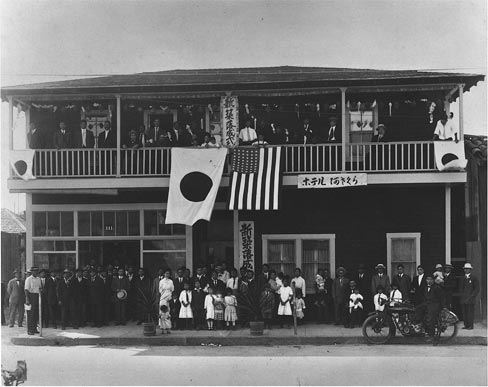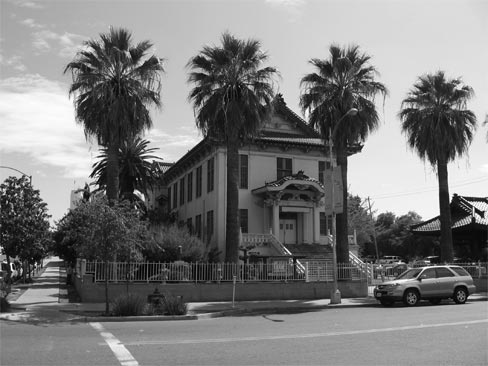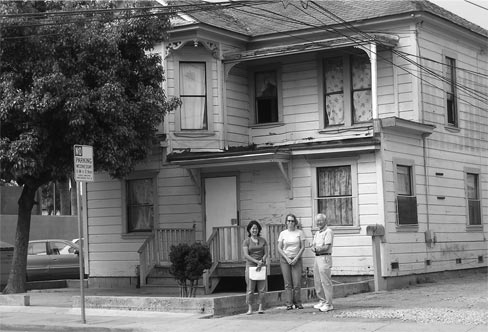Research Report
Preserving California's Japantowns
by Donna Graves
Debate about the preservation of California's historic Japantowns in Los Angeles, San Jose, and San Francisco has intensified in recent years. Development pressures, retirement of long-time community businesses, and loss of the Nisei (second) generation who rebuilt their communities after World War II stimulated concern about the future of Japantowns, or Nihonmachi. Activists and historians responding to this critical juncture found a related question emerging from their dialogues about cultural and historic preservation: "Where were California's other Japantowns and what remains of them?"
This query inspired a recent statewide effort to identify historic resources associated with dozens of Japantowns that thrived throughout California prior to World War II and provide a basis for documentation, stewardship, and interpretation of sites associated with Japanese American heritage. The Preserving California's Japantowns project is sponsored by the California Japanese American Community Leadership Council, a statewide network dedicated to addressing challenges and issues affecting the Japanese American community, and funded by the California State Library's Civil Liberties Public Education Program, which supports projects that document and educate Californians about the experiences of Japanese Americans during World War II.
California held the largest population of people of Japanese descent, or Nikkei, in the United States just before World War II, yet their historical presence is often invisible today in cities and towns where they farmed, fished, built businesses, and established institutions.(Figure 1) Wartime incarceration wreaked havoc on the physical and social fabric of communities across the West Coast, as well as on 120,000 individuals (over three quarters Californians). At the onset of World War II, most Japanese Americans did not own their homes or places of business due to discriminatory early 20th-century laws restricting Asian immigrants' rights to own property. Few Nihonmachi were able to regain their pre-war vitality, and many suffered yet again from urban renewal programs in the 1960s that destroyed what was left. The erasure of community history was one of the many painful legacies of forced removal and incarceration of Nikkei.
To help reclaim this history, in 2006-2007, Preserving California's Japantowns conducted reconnaissance-level surveys of historic resources in 43 communities across the state from Marysville to San Diego. Nihonmachi were selected to reflect the geographic, cultural, and economic diversity of California's Japanese American communities. Directories published by Japanese American newspapers provided a richly detailed primary source. Reorganized into spreadsheets, the directory listings guided the search for historic resources ranging from culturally-specific businesses such as bathhouses and tofu factories to churches and temples, community halls, and places like the ball fields where Nikkei teams played. The survey focused on sites that reflected the shared spaces of daily life: businesses, services, community halls, and religious and recreational spaces.(Figure 2) Even leaving out the residential listings, this approach generated an enormous number of locations to be surveyed.
Figure 2. Fresno's grand Buddhist temple was built in 1920 after a fire destroyed the original 1902 structure. Preserving California's Japantowns surveys found a relatively large number of extant buildings that represent the heart of most Japantowns: Christian churches, Buddhist temples, community halls, and Japanese language schools. These structures were the primary places for Japanese immigrants and their children to gather as a community and preserve traditional cultural practices. (Courtesy of Preserving California's Japantowns.) |
Enlisting community support was crucial to meeting this project's ambitious goals.(Figure 3) Preserving California's Japantowns trained volunteers to survey Japantowns in the Los Angeles area and the Sacramento/Delta region. Although not necessarily the labor-saving strategy originally envisioned, the volunteer program fostered relationships with community organizations, preservation advocates, and interested residents. These personal connections promise to be important catalysts for community-based projects that emerge from the findings.
Figure 3. Preserving California's Japantowns staff Jill Shiraki and Donna Graves with Mas Hashimoto in front of his childhood home in Watsonville. The Hashimotos ran a small udon shop and sake brewery here and rented the upstairs to Dr. Frank Ito, a dentist. Previously, the building stood a few blocks north and served as headquarters for the local Japanese association. (Courtesy of Preserving California's Japantowns.) |
Recruiting Japanese American seniors to this effort helped tie the stories and personal memories, as the lived experience of California Nikkei, to buildings and landscapes across the state. Because detailed histories have not been recorded for most of these communities, gathering information from Nisei who grew up in Japantowns dramatically altered by World War II was a pressing task. The oral history component was especially critical in rural communities where directory listings only provided a post office box or rural route address.
While expecting to find some traces of the vibrant Japantowns that suffered such violent disruption during and after World War II, the historic resource surveys yielded results far more extensive than anticipated. Hundreds of previously unrecognized historic resources throughout California capture the diverse historical experiences of the state's Nikkei, from residents of urban Japantowns that featured a wide range of community institutions and services to those who worked and lived in smaller communities across the state.
The majority of historic buildings identified by Preserving California's Japantowns surveys could best be described as modest, vernacular structures reflecting the kind of working-class, immigrant history that has, for the most part, been under the radar of landmarks programs and heritage organizations. Very few announce their connections to Asian heritage through their architecture. With the rupture of public memory caused by World War II and the ensuing decades, many current residents had no idea their community once held a Japantown.
As the surveys progressed, they underscored the importance of sharing this knowledge and fostering dialogue between preservationists, local history organizations, contemporary residents, and Japanese American communities. Preserving California's Japantowns efforts to develop awareness and advocacy for newly rediscovered Japanese American historic sites was recently recognized by the Vernacular Architecture Forum, which gave the project its inaugural Advocacy Award in May 2008.
Although it was not in the original project goals, a website was created at www.californiajapantowns.org and has proved to be an important tool for sharing this work. The site includes interactive maps of San Francisco, San Jose, and Los Angeles Japantowns; historic profiles and survey highlights of about half of the communities surveyed by the Preserving California's Japantowns project; an extensive bibliography; and a prototype "Nisei Story" excerpted from a series of place-based oral histories. A grant from the National Trust for Historic Preservation helped in the development of a "preservation toolkit" for the site. Next steps include organizing all of the survey data for posting on the website and finding a long-term web host.
Preserving California's Japantowns research points to numerous avenues for further scholarly exploration and provides the basis for efforts to designate, protect, and interpret these historic buildings and landscapes. The information will help local governments, heritage organizations, and the general public to more fully understand their community history and better plan for stewardship and interpretation of California's past.
About the Author
Donna Graves is Project Director of Preserving California's Japantowns. She is an historian and cultural planner based in Berkeley, California. She can be reached at dgraves3@mindspring.com.



